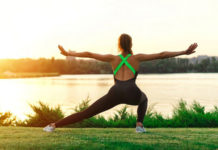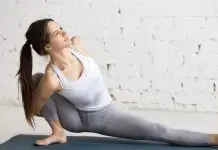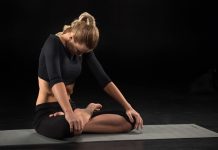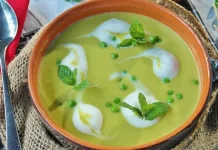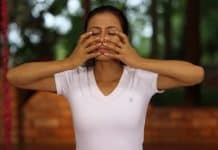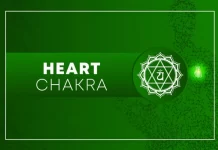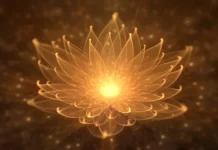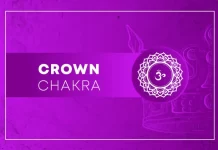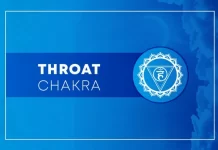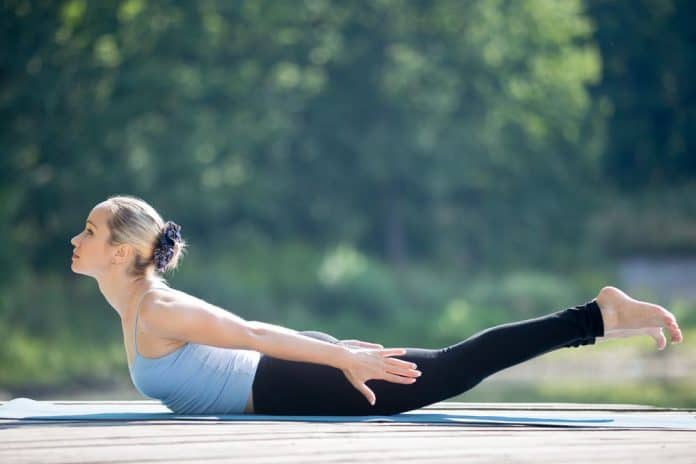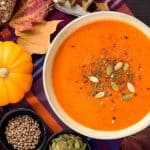A prone yoga pose that bends the back is called Shalabhasana. It’s one of the “baby backbends” that aids newer yoga practitioners in developing their backbend technique. After performing this pose, you could experience physical alleviation from the muscles that cause back pain.
Shalabhasana’s backbend movement differs from other backbends in the following ways:
- The only backbend in which we do not engage the opposing movement to prevent the posture from taking place—back extensors—is Shalabhasana.
- In other backbends, we push against our arms and legs to deepen the stance. But here, we struggle against gravity in the same way.
Shalabhasana is primarily used to increase flexibility and to awaken and strengthen the back extensor muscles.
Meaning
Shalabh means grasshopper or locust in Shalabhasana, while asana denotes position. The locust position is so-called because the body’s extended torso and spread hands resemble a locust resting on a field.
This pose gives the spine a gentle stretch. But to extend out and lift hands and legs at the same time, one needs to have strong upper and middle back muscles.
- Swami Vishnudevananda wrote a description of this asana in 1960 under the title “Complete illustrated book of the yoga” according to Shivanada’s tradition.
Practice Guide of Shalabhasana
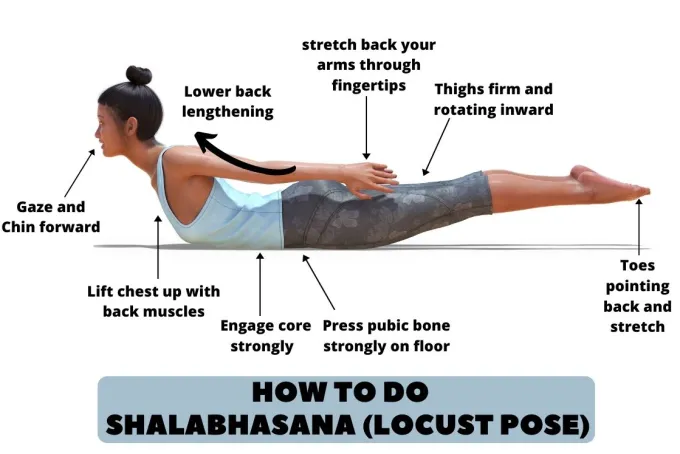
If you want to perform Shalabhasana safely and easily, read the points below.
Precautions and Contraindications
- Women who are pregnant or menstruating shouldn’t perform Shalabhasana.
- Avoid doing this pose if you have a spine injury. When the discomfort has subsided, practitioners with lower back pain can resume light practice, but they should avoid injuring the problematic area.
- Patients with high blood pressure should refrain from holding Shalabhasana for prolonged periods of time.
- It is not advised for people to perform Shalabhasana who have a hernia, potbelly, or who recently had surgery.
Preparatory Pose
- Hero Pose (Virasana)
- Cobra Pose (Bhujangasana)
- Cow Pose (Gomukhasana)
Shalabhasana Steps
- On your mat, start by lying on your back. Your palms are on the floor with your side of the torso touching them and your forehead resting on the ground.
- Lift your head, chest, and leg off the floor at the same time as you exhale. By raising your limbs, you can stretch them as much as possible.
- Do not let your ribs rest on the ground, always. Only the front abdomen and pelvis are supported by or remain on the floor.
- Stretch your thigh muscles while contracting your buttocks. Knees, thighs, ankles, and both fully extended legs should touch.
- Your chin should remain parallel to the floor, and you should fix your gaze forward or slightly upward. Verify whether the back of your neck is being compressed.
- The Shalabhasana, also known as Purna Shalabhasana, is now complete. The final step will result in concave-shaped legs and a torso that have been stretched and elevated.
Release
As long as your breathing is regular, keep your stance. It would be challenging to maintain the posture at first, but as the core gets stronger, the holding time will vary.
Usually, you hold the position for 30 to 1 minute before exhaling to release it. In the same manner that you entered the pose, gradually lower your limbs, followed by your torso, pelvis, and head.
Beginners Tips
- Beginners may find it difficult to lift both legs into the air. As an alternative, one could lift each leg (both left and right) one at a time for a set amount of time.
- Another difficulty for the novice to handle is the chest’s dissociation. To achieve this, one can place hands along the waist or just behind the shoulders, and then exert pressure to feel elevated.
Props and Modifications
- While balancing the body over the chin, there is a possibility of injury. The solution can involve tucking a blanket under the chin or swapping the chin for the forehead.
- If there is pressure under the chest, a folded blanket can be placed there. This will help to keep the posture in place without impacting respiration.
- Beginners can elevate their thighs more easily by placing their hands beneath the latter. Though it can result in an injury, avoid putting weight on the wrist.
Follow up Pose
- Boat Pose (Naukasana)
- Bridge Pose (Sethu Bandha Sarvangasana)
- Bow Pose (Dhanurasana)
Variations
The following asanas can be used as a variation of Shalabhasana.
1. Ardha Shalabhasana
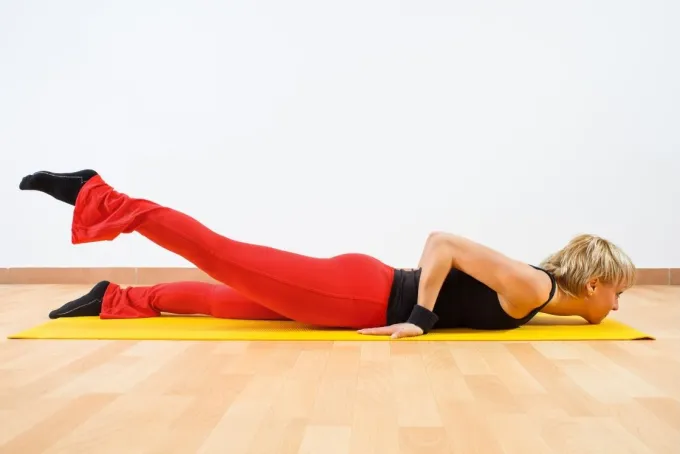
An effective prelude to the Purna Shalabhasana is the Ardha Shalabhasana.
Practitioners can simultaneously elevate one arm and the other leg in this position. For instance, lift the left leg and right arm off the ground along with the other matching limbs. Then, with the other two limbs on the floor, the right leg and left arm should be elevated.
2. Makarasana
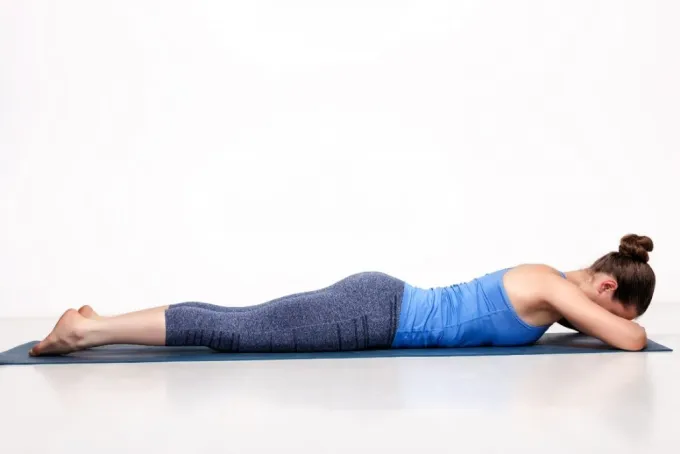
Shalabhasana can be modified into the crocodile position known as Makarasana.
Shalabhasana allows you to lay prone and lift your head while keeping your elbows on the floor and your palms underneath your jaws. With their toes pointed outward, their legs are stretched apart. Allow your body to feel anchored.
Shalabhasana Benefits
- This pose improves the lower back, erector spine, upper back, and back extensor muscles’ strength, power, and endurance. Effects of specific Asanas on female students’ back extension, per one study http://www.journalofsports.com/pdf/2018/vol3issue2/PartH/3-2-64-447.pdf [/efn_note], regular practice results in back extension in females.
- In the event of gastrointestinal issues like flatulence, indigestion, etc., Shalabhasana offers relief. It improves and restores the function of the digestive organs by exerting pressure on them.
- This asana’s stretching enhances the spine’s flexibility, which eliminates pain in the sacrum and lowers the back. Research suggests [efn note] Effect of Yoga in Premenopausal Women with Chronic Low Back Pain on Pain, Brain-Derived Neurotrophic Factor, and Serotonin https://www.hindawi.com/journals/ecam/2014/203173/ [/efn_note], Serum BDNF (Brain-derived neurotrophic factor) and serotonin levels are significantly impacted by Shalabhasana practice and other yoga therapies. The therapeutic effects of yoga on chronic low back pain may be mediated by these neuromodulators in the nociceptive pathway.
- Shalabhasana, which involves applying pressure on the belly, provides health benefits for the uterus, bladder, and prostate among other internal organs (female).
- In this pose, raising the legs increases blood flow to the pelvic area, which improves nutrient delivery to the reproductive system. Therefore, consistent practice enhances sexual endurance as well as restores sexual potency.
- After holding Shalabhasana for a while, the muscles are actively used throughout the motions. As a result, muscles that are returning relax. This calms and creates a quiet atmosphere that eliminates stress and anxiety.
- In contrast to the vertical position, where gravity exerts resistance, the horizontal position of the body allows for optimal circulation. Therefore, doing this asana regularly assures improved blood flow throughout the body.

